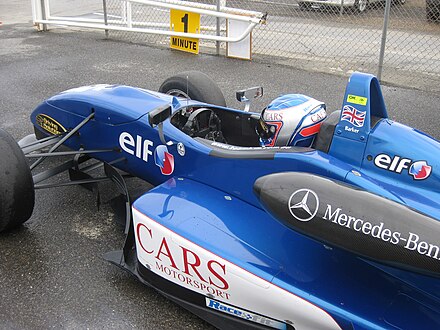Australian Drivers' Championship — чемпионат по автогонкам, ежегодно проводимый с 1957 года водителями автомобилей, соответствующих высшей категории гонок на открытых колесах в Австралии. Эта категория определялась Конфедерацией австралийского автоспорта до 2023 года. С 2024 года в чемпионате принимают участие водители автомобилей, соответствующих высшей категории гонок на открытых колесах в Австралии, определяемой Австралийским автомобильным спортивным альянсом . Каждый год победитель награждается Золотой звездой — с 1957 по 2023 год — Золотой звездой CAMS [1] , а с 2024 года — Золотой звездой AASA.
Australian Drivers' Championship — третий старейший непрерывно присуждаемый титул в австралийском автоспорте, только Australian Grand Prix (с 1928 года) и Australian Hillclimb Championship имеют более длинную непрерывную историю. Хотя изначально он задумывался как главный приз для внутренних автогонок, со временем он утратил свою значимость и с 1980-х годов фактически стал подготовительной серией для Australian Touring Car Championship и V8 Supercars Championship или стартовой площадкой для водителей, желающих начать международную карьеру.
В 2024 году под новым руководством AASA произошло историческое изменение направления. С целью поиска самых талантливых водителей в Австралии была переосмыслена главная категория гонок с открытыми колесами, и теперь она служит витриной для водителей, чей талант вождения является ценным активом. Этот новый фокус направлен на то, чтобы сделать чемпионат более доступным и конкурентоспособным за счет существенного сокращения расходов, тем самым предоставив водителям с ограниченными финансовыми возможностями возможность продемонстрировать свои навыки вождения. Автомобиль, выбранный для осуществления этого изменения, — Hyper Racer X1, разработанный и произведенный в Австралии.
Первый титул в 1957 году был открыт в регламенте, фактически Formula Libre . Хотя эпоха «австралийских специальных» гоночных автомобилей, разработанных вручную местными механиками/инженерами вдали от европейских/американских производителей, которые доминировали в гонках до Второй мировой войны, еще не умерла, в частности, серия специальных автомобилей Maybach все еще была конкурентоспособной, поскольку подержанные автомобили Формулы 1 и Формулы 2 из Европы становились все более популярными среди участников, а Maserati 250F нашел несколько пристанищ в высшем эшелоне гонщиков.
Подъем Cooper в Европе, возглавляемый Джеком Брэбэмом , Брюсом Маклареном и остальным австралийско-новозеландским вторжением, которое хлынуло в Формулу-1 в 1960-х годах, привел к увеличению эффекта просачивания вниз, поскольку более дешевые пакеты с задним расположением двигателя быстро стали популярными среди участников. Конкурентный характер гонок, а также репутация антиподного персонала в Европе заставили заводские команды обратить внимание на гонки в Австралии/Новой Зеландии во время европейской зимы. Это привело к разработке правил серии Тасман и потоку Cooper и Brabham в австралийские гонки, а также поощрению роста отечественных производителей, таких как Elfin Sports Cars .
По мере того, как серия Tasman угасала, был значительный толчок к двухлитровой открытой формуле, чтобы заменить правила Tasman, однако, поскольку Formula 5000 уже имела прочные позиции среди конкурентов, двухлитровая формула отошла на второй план. В то время как F5000 была популярна на этом этапе, Australian Touring Car Championship превзошел ее по популярности, и эта ситуация сохранится до сегодняшнего дня, когда Australian Drivers' Championship теперь рассматривается как категория для развития молодых водителей.
Формула 5000 продолжалась до 1981 года, при этом на некоторых площадках количество участников сократилось до менее десяти машин, был принят местный вариант Формулы Atlantic , который уже использовался с конца 70-х годов и сразу же оказался успешным с большим количеством импортированных Ralt RT4. Но Pacific, или Формула Mondial, как ее позже переименовали, сошла на нет к 1987 году, и местная австралийская категория Формулы 2 была принята для одной гонки в 1987 году и для сезона 1988 года, в то время как была разработана формула на основе Формулы 3000 , позже названная Формулой Holden . Формула Holden проводилась с 1989 по 2003 год, к тому времени эта формула стала нежизнеспособной, международная смерть Формулы 3000 привела к иссяканию поставок шасси. В 2005 году были приняты международные правила Формулы 3 .
Сокращение числа участников на стартовой решетке австралийской Формулы-3 привело к тому, что CAMS впервые в своей истории решила не вручать Золотую звезду в 2015 году. [2] Это решение было принято после начала сезона.
В 2020 году было решено возродить Золотую звезду для серии S5000 Australian Drivers' Championship для V8 open wheelers. Пандемия COVID-19 помешала провести чемпионат в 2020 году, отложив вручение титула до мая 2021 года. Гонки S5000 были поставлены на неопределенный срок с 2024 года. [3]


,_Dallara_F304.JPG/440px-84_2006_Aust_F3_C'Ship,_Ben_Clucas_(UK),_Dallara_F304.JPG)
